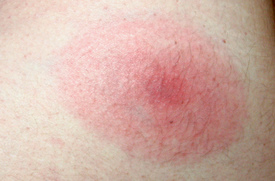Symptoms of Lyme disease in dogs are much different than what infected humans experience.
This page explores the differences along with proper diagnosis and the most common treatment:
- Brief History & Definition of Lyme Disease
- Lyme Disease in Humans
- Dog Lyme Disease & Lyme disease prevalence by country/state/province
Lyme Disease: A Brief History & Definition
Most of us have heard about Lyme disease periodically since the first case was reported in 1975 after an excessive number of childhood arthritis cases were reported near Lyme, Connecticut. Since then, reports of Lyme disease have been on a steady rise.
Lyme disease is a bacterial infection that is carried by the Black-legged tick. This disease can cause problems with the heart, joints and nervous system. It is usually transmitted by ticks in the nymphal stage, meaning young ticks, after two or more days of feeding on its host.
The longer a tick is attached, the higher the likelihood that Lyme disease will be transmitted. Therefore, the younger, smaller ticks are able to transmit Lyme disease more effectively by going unseen for longer periods of time.
Lyme Disease in Humans: Symtpoms & Treatments
In humans, symptoms of Lyme disease include a “bulls-eye” rash (pictured right) or a rash in the form of a ring, which develops 3 to 32 days after a bite from an infected tick.
Symptoms may also include fever, headache, muscle ache, joint aches, significant fatigue, facial paralysis and cardiac arrhythmias. Late symptoms can include chronic arthritis and nervous system abnormalities.
If Lyme disease is caught within its early stages in humans, it is usually treatable with antibiotics.
Lyme Disease in Dogs: Symptoms, Diagnosis & Treatment
Unlike humans, dogs do not develop a circular rash upon being infected with Lyme disease. Symptoms of Lyme disease in dogs include:
Lyme Disease
in Your Area
To learn about the prevalence of Lyme disease in your state or country, see the following resources:
- Australia: Lyme disease is very rare in Australia if it exists at all. Click here for more information.
- Canada: Canadian Lyme Disease Foundation. Also see this information posted by the CMAJ.
- United Kingdom: Lyme Disease Action
- United States: The American Lyme Disease Foundation’s site allows you to search for Lyme Disease prevalence by state.
- Lameness in one or both legs
- Lethargic or sluggish behavior
- Loss of appetite
- Fever
- Sensitivity to the touch
- Swelling of the joints
- Swollen lymph nodes
- Walking stiffly with a hunched back
Dog Lyme disease can be difficult to diagnose by symptoms alone given the length of time the symptoms take to set in… anywhere from 2 to 5 months after your dog has been bitten by a tick carrying the disease.
If your dog displays any of the above symptoms and your dog has been bitten by a tick over the last several months, get to the vet right away. The longer the disease remains in your dog’s system, the higher the risk for serious problems to arise, including major effects on the heart, kidneys and central nervous system.
If you live in an area with a higher prevalence of Lyme disease (see the links in the box above) and your dog is bitten by a tick, you may want to play it safe and have your dog’s blood tested right away using a special test called a Lyme titer.
For infected dogs, Lyme disease treatment usually consists of giving antibiotics for a period of at least 30 days. As long as your dog is treated quickly after being infected, this method of treatment is very effective.
Natural & Holistic Note: Despite our desire to treat our dogs naturally whenever possible, suspected Lyme disease is a situation where its better to administer antibiotics quickly rather than wait and risk the spread of infection.
Do you believe in holistic pet care? If so, please tell your friends about us, and visit our Organic Pet Digest social media accounts. Thank you for supporting our efforts!
Also see…
- Natural dog flea medicine (includes additional recommendations for dog flea and tick medicine, prevention and control for your dog, home and yard)
- Skin conditions and disorders (includes parasites other than ticks)
- Benefits of Apple Cider Vinegar

